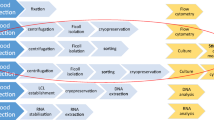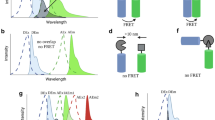Abstract
Rats were injected with59Fe-ferrous citrate and bled thereafter at different times (16 h to 49 d). This gave rise to red cell populations in which cells corresponding in age to the time elapsed between injection and bleeding were labeled. The anticoagulant used was either acid-citrate-dextrose (ACD) with a pH adjusted to 7.3 or ACD (pH 5.1). Final pH of the collected blood was about 7.2–7.4 in the former case and 6.4–6.7 in the latter. Red cells were then centrifuged (5) and approximately 7–10% of the packed cells from the top and 7–10% from the bottom of the cell column collected. When reticulocytes are the predominant labeled red cell population, as in blood obtained for about 24 h after isotope injection, a fractionation of these cells and mature erythrocytes is in evidence only when blood is collected at the higher pH. Thus, at pH 7.2–7.4 ratios of specific radioactivities of cells in top fraction/cells in an unfractionated sample are about 3, whereas at pH 6.4–6.7, the analogous ratios are 1 or less. These differences in specific activity ratios, as a function of pH at collection, virtually disappear after about 4 d following isotope injection.
The lower pH is known to increase the volume and decrease the density of mature red blood cells. The marked effect of pH on cellular fractionation could be correlated with the smaller change in rat reticulocyte density and volume in acid medium. At pH 6.4–6.7, the densities of mature erythrocytes and reticulocytes are so close that their physical separation by centrifugation is not feasible.
Similar content being viewed by others
References
Legge, D.G. and Shortman, K. (1968),Brit. J. Haematol. 14, 323.
Shortman, K. and Seligman, K. (1969),J. Cell Biol. 42, 783.
Clark, M. R. (1988),Physiol. Rev. 68, 503.
Bishop, C. and Prentice, T. C. (1966),J. Cell. Physiol. 67, 197.
Murphy, J. R. (1973),J. Lab. Clin. Med. 82, 334.
Walter, H., Krob, E. J., Pedram, A., Tamblyn, C. H. and Seaman, G. V. S. (1986),Biochim. Biophys. Acta 860, 650.
Walter, H., Miller, A., Krob, E. J. and Ascher, G. S. (1972),Exp. Cell Res. 73, 145.
Kratky, O., Leopold, H. and Stabinger, H. (1973),Methods Enzymol. 27, 48.
Hinghofer-Szalkay, H., Kenner, T., Leopold, H., Moser, M. and Wurm, H. (1982),Cardiovascular System Dynamics: Models and Measurements, Kenner, T., Busse, R., and Hinghofer-Szalkay, H., eds., Plenum, New York, pp. 441–451.
Walter, H. (1985),Partitioning in Aqueous Two-Phase Systems. Theory, Methods, Uses, and Applications to Biotechnology, Walter, H., Brooks, D. E., and Fisher, D., eds., Academic, Orlando, FL, pp. 327–376.
Walter, H. and Krob, E. J. (1989),J. Chromatogr. 479, 307.
Morrison, M., Jackson, C. W., Mueller, T. J., Huang, T., Dockter, M. E., Walker, W. S., Singer, J. A. and Edwards, H. H., (1983),Biomed. Biochim. Acta 42, 107.
Canessa, M., Fabry, M. E., Blumenfeld, N. and Nagel, R. L. (1987),J. Membrane Biol. 97, 97.
Lauf, P. K. (1983),J. Membrane Biol. 73, 247.
Duhm, J. and Gobel, B.O. (1984),Am. J. Physiol. 246, C20.
Walter, H., Krob, E. J., Tamblyn, C. H. and Seaman, G. V. F. (1980),Biochem. Biophys. Res. Commun. 97, 107.
Author information
Authors and Affiliations
Rights and permissions
About this article
Cite this article
Walter, H., Krob, E.J., Wenby, R.B. et al. Differential effect of pH on the density and volume of rat reticulocytes and erythrocytes. Cell Biophysics 16, 139–148 (1990). https://doi.org/10.1007/BF02991427
Received:
Accepted:
Issue Date:
DOI: https://doi.org/10.1007/BF02991427




